Yellow Fever

Introduction:
Yellow fever is a serious disease that can affect people in different parts of the world, including India. It is caused by a virus that is transmitted through the bites of infected mosquitoes. In this article, we will explore what yellow fever is, its signs and symptoms, how it is classified, the causes and triggers, risk factors with examples, types of yellow fever, diagnostic tests, treatment options, and prevention techniques.
Signs and Symptoms:
When a person gets infected with yellow fever, they may experience various signs and symptoms. Some common ones include:
- Fever: A high fever is one of the main signs of yellow fever.
- Jaundice: The skin and eyes may turn yellow due to a condition called jaundice.
- Headache: People with yellow fever often have severe headaches.
- Muscle pain: Muscles can become painful and achy.
- Nausea and vomiting: Infected individuals may feel nauseous and may vomit.
- Fatigue: Yellow fever can make people feel extremely tired and weak.
What Is Yellow Fever?
Yellow fever is a viral disease caused by the yellow fever virus. It primarily spreads through the bites of infected mosquitoes, particularly the Aedes aegypti mosquito. This virus belongs to the Flaviviridae family and can cause severe illness, affecting the liver, kidneys, and other organs.
How Is Yellow Fever Classified?
Yellow fever can be classified into two main types:
-
Urban Yellow Fever: This type occurs in cities or densely populated areas where the Aedes aegypti mosquito thrives. People in urban areas can easily become infected when bitten by infected mosquitoes, leading to outbreaks.
-
Jungle (Sylvatic) Yellow Fever: This type occurs in remote forested areas, where non-human primates serve as the primary reservoir for the virus. Humans can contract jungle yellow fever when venturing into these areas and getting bitten by infected mosquitoes.
Causes and Triggers:
As mentioned earlier, yellow fever is caused by the yellow fever virus, which is primarily transmitted through mosquito bites. When an infected mosquito bites a person, the virus enters their bloodstream and starts to multiply, leading to the onset of symptoms.
Risk Factors with Examples:
Certain factors can increase the risk of contracting yellow fever:
-
Living in or Traveling to Endemic Areas: People living in or traveling to regions with a history of yellow fever outbreaks are at higher risk. For example, in India, people living near forested areas where the Aedes aegypti mosquito is prevalent could be at risk.
-
Lack of Vaccination: Individuals who have not received the yellow fever vaccine may be susceptible to the disease.
Types of Yellow Fever:
As discussed earlier, yellow fever is classified into urban and jungle types. The urban type spreads rapidly in cities due to the dense population, while the jungle type usually affects people who venture into forested areas.
Diagnostic Tests and Treatments:
Diagnostic Tests:
There are several tests to diagnose yellow fever:
-
Blood Tests: A blood sample is taken to detect the presence of the yellow fever virus or antibodies produced by the immune system in response to the infection.
-
Polymerase Chain Reaction (PCR) Test: This test detects the genetic material of the yellow fever virus and is used to confirm the infection.
-
Immunohistochemistry: In severe cases, a tissue sample from the liver or other affected organs may be analyzed to identify the virus.
Treatments:
Unfortunately, there is no specific treatment for yellow fever. However, supportive care can help manage the symptoms and complications. This includes:
-
Rest: Getting plenty of rest is essential for the body to recover.
-
Hydration: Drinking fluids helps prevent dehydration caused by fever and vomiting.
-
Pain and Fever Relief: Over-the-counter medications can help reduce fever and alleviate pain.
Complications of Yellow Fever:
Yellow fever can lead to severe complications, such as liver and kidney failure, bleeding disorders, and shock. In some cases, it can be fatal.
Prevention Techniques:
The best way to prevent yellow fever is through vaccination. The yellow fever vaccine is safe and highly effective in providing immunity against the virus. Additionally, taking preventive measures against mosquito bites, such as using mosquito repellents, wearing protective clothing, and staying indoors during peak mosquito activity, can reduce the risk of infection.
Yellow fever is a serious disease that can cause significant harm if not prevented or diagnosed early. By understanding the signs, symptoms, risk factors, and prevention techniques, people in India and other parts of the world can protect themselves from this potentially deadly virus. Vaccination, mosquito control, and early medical attention are crucial in combating yellow fever and ensuring a healthy future for all. Stay informed, stay protected!
What's Your Reaction?
 Like
0
Like
0
 Dislike
0
Dislike
0
 Love
0
Love
0
 Funny
0
Funny
0
 Angry
0
Angry
0
 Sad
0
Sad
0
 Wow
0
Wow
0








































































